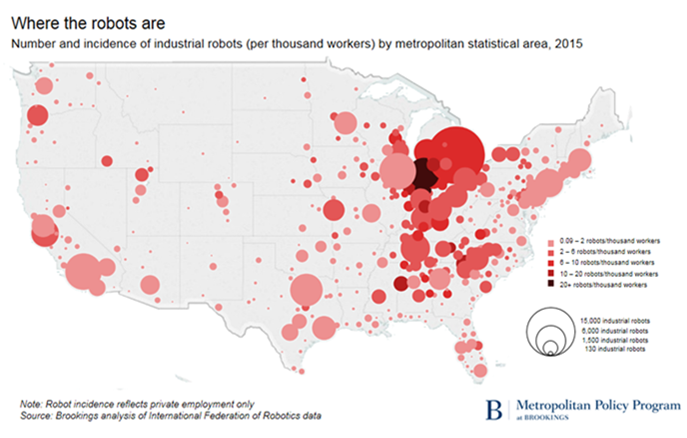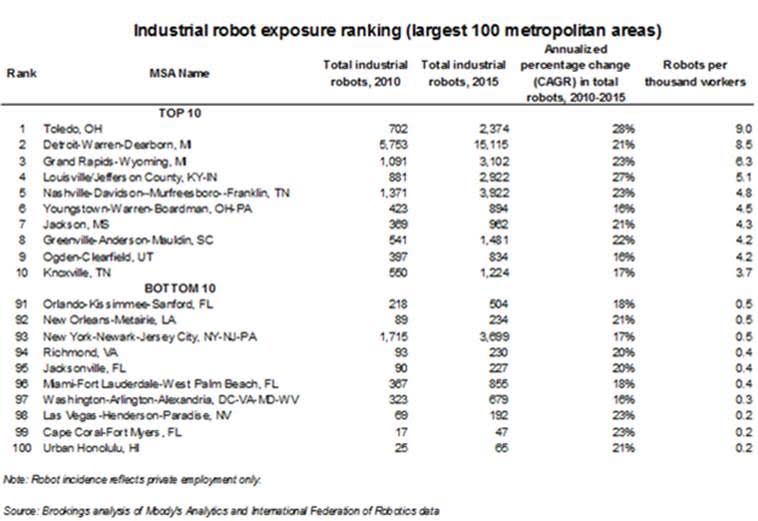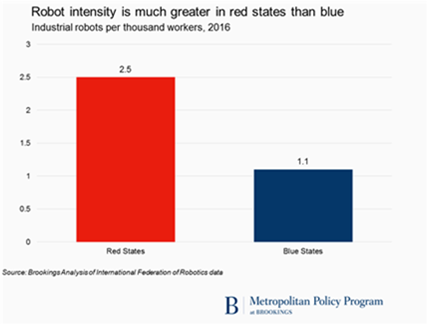Where Are Robots Affecting American Industry the Most?
Credit to Author: Ankita Rao| Date: Mon, 14 Aug 2017 16:16:07 +0000
There are two conflicting forces affecting the US workforce right now: the effort to bring back outsourced manufacturing jobs, and the push to automate industrial jobs using robots. These are, unsurprisingly, colliding in the same regions of the country.
Researchers at the Brookings Institute’s Metropolitan Policy Program mapped out exactly where the estimated 233,305 industrial robots—which they define as automatically controlled, reprogrammable machines—are proliferating. To do this, they used data from a recent economics paper from MIT and Boston University on robots and jobs, which analyzed sales data from the International Federation for Robotics.

Industrial robots are largely concentrated in manufacturing hubs in the Midwest and South. More than half are located in 10 states, led by Michigan, Ohio, Indiana, and Tennessee. Detroit—the heart of America’s automobile industry—has more than 15,000 industrial robots—8.5 per 1,000 workers.

But it’s not just large metropolitan areas where robots are making their mark. Several small towns and cities are home to even higher robot densities. There are 16.6 robots for every 1,000 workers in Morristown, Tennessee, where 9,000 people work on industrial tasks like processing poultry and manufacturing aluminum pistons.

Both the Midwest and the South have been rife with anxiety about losing jobs, which helped determine how they voted in the most recent presidential election. Many states with the highest rates of unemployment fall within these regions, and voted for Donald Trump partly because of his promise to bring back manufacturing jobs.
“People are not wrong in this region to suspect that automation has disrupted the labor market,” Mark Muro, senior director of the Metropolitan Policy Program at the Brookings Institute, told me over a phone call. (Trump, however, blamed the loss of jobs on globalization and immigration, rather than automation.)
He said anxiety about automation-led job loss in these regions played a substantial role in the election. But Republicans have resisted possible solutions for industrial workers whose jobs are threatened by robots: Policies such as portable retirement accounts, wage assurance, and relocation support have been largely rejected by the party so far, Muro said.

The Brooking’s report was specific to industrial robots, so other technologies, including artificial intelligence, weren’t mapped and may have different geographical impacts. Muro’s team is currently working on a larger project that will include other types of robots as well.
Nevertheless, the future of the US labor force depends on knowing exactly how, when, and where robots are being employed to do formerly human jobs. Experts and lawmakers need to understand the geographic dispersion of automation in order to plan for these technologies when designing policies that provide ample economic opportunities to everyone.
“There will clearly be substantial disruption in the interim as we transition from one technology base to another,” Muro said. “Given that, I think the nation, and policymakers, need to be thinking much more deeply about what that might mean.”
Get six of our favorite Motherboard stories every day by signing up for our newsletter.